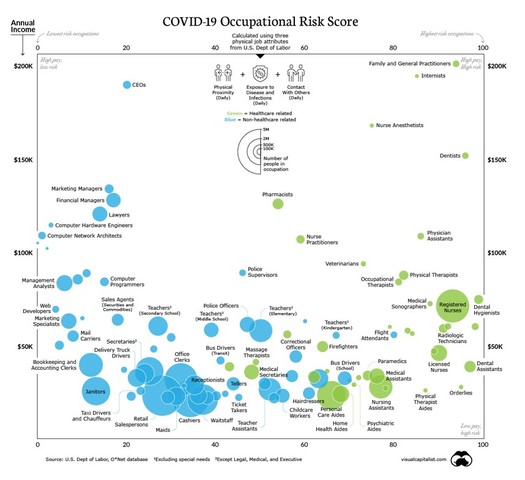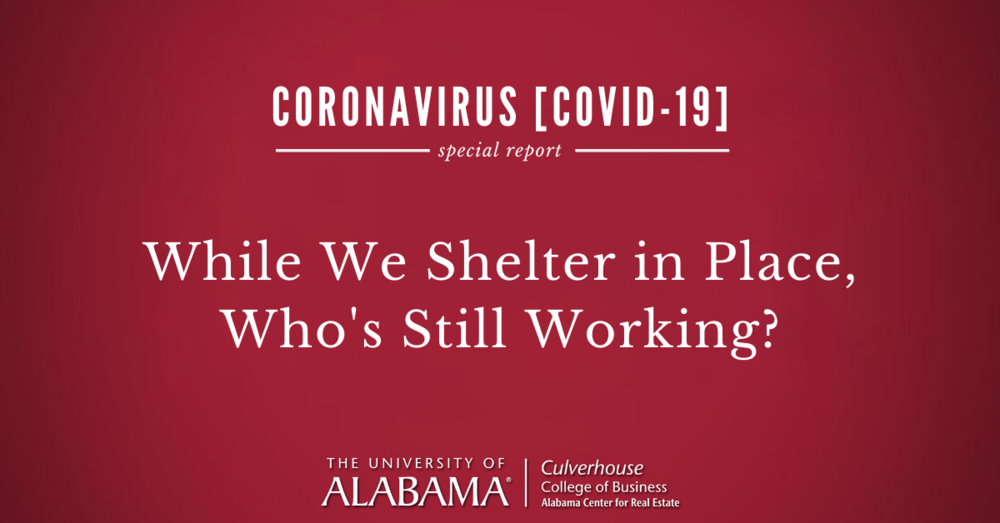A disproportionate amount of COVID-19 coverage globally has been – and continues to be – dedicated to “what’s not working.” This article’s focus is pivoting to “who’s still working.” The idea originated from a recent Visual Capitalist feature that highlights the breadth of workforce on duty to support not just COVID-19 victims, but the entire supply-chain workforce needed to be on duty so the majority of us can shelter in place comfortably with utilities, water, food, delivery service from FedEx and UPS, WiFi and Zoom connectivity, Netflix entertainment, trash pickup, and much, much more. What is also eye-opening in the Visual Capitalist occupational risk score graphic below is the wage disparity between those risking their health and exposure to COVID-19 to support us and our supply chain compared to those that can work at home via computers with technologies like Zoom or Skype. Consider the following graphic and focus on the green and light blue bubbles in the bottom half of the chart. These bubbles represent the myriad of medical, first responder, retail, education, transportation and supply-chain workforce essential to our economy (not sheltering in place) and making lower wages (primarily $25-75,000). It elevates the questions: Why do we pay “essential workforce” the lowest wages in our economy? Should we rethink this wage disparity post COVID-19, and how should we show gratitude post COVID-19?

Anyone given thought to sign language interpreters? The significance of the preceding graphic came further into focus from a story in the Rivard Report from San Antonio, Texas, on April 26, 2020, about sign language interpreters during the coronavirus outbreak. The article detailed the risks that sign language interpreters are taking to be on duty, as well as the challenges they face developing new signs to describe, for example, coronavirus or PPE (Personal Protective Equipment) or the CARES bill and the PPP (Paycheck Protection Program) lending program. There is no official committee or agency that approves signs. It is largely regional and community based. Languages develop geographically; therefore, our American word for coronavirus is different from the sign language they’re using in France or Britain. And ASL signing is not uniform or just “one sign fits all” in English or across the world. American ASL is as different in Texas or New York as it is in America versus European or Asian countries. Finally, don’t overlook that a “sign” for coronavirus or COVID-19 did not previously exist.
The new reality is that televised news events – and even Zoom and Skype webinars by government agencies, industry group virtual conferences by the likes of Fannie Mae, NAR and CCIM Institute – now have an American Sign Language (ASL) interpreter present turning each emerging COVID-19 phrase into gestures for our deaf or hard of hearing colleagues and public. Finally, note that “Closed Captioned” on screens or TV do not work so well when people are wearing face masks. The ASL community is on duty and having to respond extemporaneously to a whole new coronavius-era language. They are another group working during COVID-19.
There are many other aspects of our economy still working. The Federal Reserve is on duty similar to the Lehman and AIG crises in 2009 when teams worked 24/7 at the New York Federal Reserve Bank with their families traveling in to visit on weekends so nobody had to leave during that crisis. The Federal Reserve has been quick to respond to the COVID-19 public crisis with innovative and broad-based intervention keeping markets liquid and putting holes in the dike until Congress would respond with legislative action. And oil storage workers are maxed out in places like Cushing, Oklahoma, which stores approximately 13% of U.S. oil or 900 million barrels.

A lot is still working in Alabama as well, despite auto and aircraft manufacturing being idled, restaurants closed, and beaches off-limits – we hope temporarily. A good example of small and old industry working big and in adaptive reuse fashion in Alabama is at HomTex based in Cullman, Alabama. According to Made In Alabama, HomTex (a manufacturer of bed linens and other items) has shifted its focus from traditional products to making cotton face masks for businesses and individuals. This was possible due to the assistance of the Alabama Department of Commerce and Cullman County Economic Development Agency – also still working – which helped quickly secure a $1.5 million loan to purchase the needed manufacturing equipment to retool. This loan will enable the purchase of needed equipment to manufacture facemasks. According to HomTex CFO Jeremy Wootten, this face mask project will make HomTex one of the largest domestic manufacturers of this product – and the creator of 120 new jobs.
This week when the earnings of one-third of our public companies release and we receive more distressing data from the retail, transportation, restaurant, and travel industries, let us not lose sight of what is working and deteriorate into a dystopia – an imaginary place where life is extremely bad because of deprivation or oppression or terror. Alabama Secretary of Labor Fitzgerald Washington is working. The Alabama Chambers of Commerce from the interior of Alabama to the large metros in Birmingham, Mobile, Montgomery and Huntsville are working. The port of Mobile is working and preparing itself for more supply-chain activity (containers, autos, and bulk cargo). The universities are working with online learning, successfully seeing to it that our future workforce is ready and not disrupted by COVID-19. And last, but certainly not least, Alabama’s essential workforce is working.





